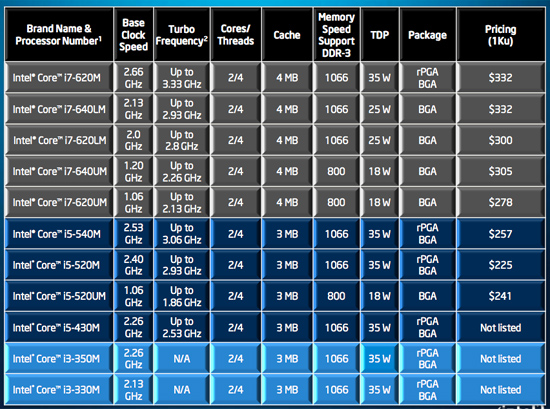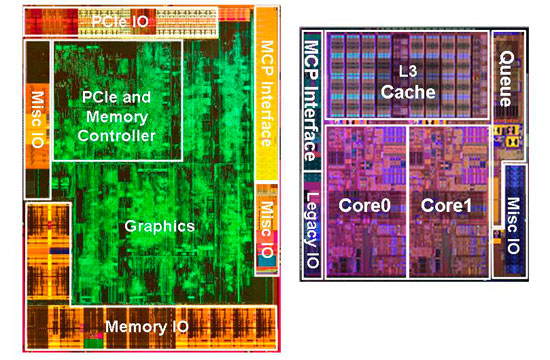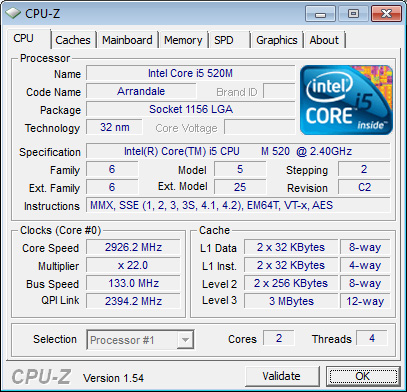Apple's 15-inch Core i5 MacBook Pro: The One to Get?
by Anand Lal Shimpi on April 14, 2010 10:38 PM EST- Posted in
- Mac
- MacBook Pro
- Arrandale
- Core i5
- Laptops
Faster, Not Slower
The 15-inch and 17-inch MacBook Pros offer your choice of Core i5 or i7 processors. If you follow Intel’s model numbers, you can get either a Core i5 520M, 540M or Core i7 620M. These chips run at 2.40GHz, 2.53GHz or 2.66GHz by default.
Wait! But the old 15-inch MacBook Pro ran at 2.53GHz, 2.66GHz or 2.80GHz by default. These new models are slower! After reading that a few times online yesterday, I knew it was time for a quick refresher on microprocessor architecture and performance.

Intel's Arrandale Lineup
There are three ways we can improve CPU performance these days: increase clock speed, increase IPC or increase thread count. The first improvement is the obvious one. Keep all other variables the same, just make the chips run at a higher frequency. The second one requires that we increase the amount of work our CPU does in each clock cycle (increasing the number of instructions completed per clock, or IPC). And the third one is to simply increase the number of simultaneous threads our CPU can handle, either through multiple cores or multiple threads per core.
With Arrandale, the mobile Core i5 and i7, Intel actually used all three tricks to improve performance.
I’ll start with the middle improvement: increasing IPC. Arrandale brings a dual-channel memory controller on-package (it’s actually on the GPU and not the CPU as you may remember). This improves bandwidth which in turn keeps the CPU cores fed with data and thus increases overall IPC.

The Arrandale die. Graphics on left, CPU on right.
The cache hierarchy has changed quite a bit since the Core 2 days. Instead of a large shared L2 cache, each of the two Arrandale cores have their own private 256KB L2 cache. The cache is the fastest of any desktop CPU today requiring only 10 cycles to access it. As I wrote in the past, the L2 is quickly becoming the new L1 so low latency access matters more than size. The catch-all cache moves down a level and Arrandale has a large 4MB L3 cache. On the Core i7s you get the full 4MB, while the i5s disable 1MB leaving you with 3.

There are some instruction and execution level improvements as well, which I’ve detailed here and here. Specific to Arrandale (and the rest of the Westmere family) are new AES instructions designed to accelerate encryption/decryption operations.
The takeaway here is any slight drop in default clock speed is at least partially negated by the increase in performance per clock. If that’s not enough, Arrandale also brings Turbo Boost to Intel’s mobile chips.
These Core i5 and i7 processors have about a million transistors dedicated to power management. It’s a little section of the CPU called the PMU (Power Management Unit). The PMU monitors CPU temperatures, current draw and power consumption. Based on these inputs as well as the current load on the CPU, the PMU can tell the rest of the CPU to increase its clock frequency. The CPU is allowed to increase its operating frequency in 133MHz steps up to a predefined max speed. The max speed is determined by Intel as well as the number of cores that are actively doing work on the chip.
The whole process works like this. If you have all cores active and the workload they’re running isn’t maxing out the CPU’s specified current or power draw, the cores can run at a higher frequency. If you have only one core active, the other core is power gated (effectively shut off) and the active core is allowed to turbo up several bins as long as it remains within its current, temperature and power limits.
The result is that most of the time your 2.40GHz Core i5 runs at 2.66GHz, and if you’re only running single threaded applications you’ll see it bounce from 2.66GHz to 2.80GHz and 2.93GHz. So even if the IPC improvements brought on by Arrandale weren’t enough, you’ll rarely run at your base clock speed when you need the performance. Intel’s Turbo Boost works beautifully in practice and the transition to OS X seems to have gone well.

The 2.40GHz MacBook Pro running at 2.93GHz thanks to Turbo
The final vector for performance improvement is by increasing the number of threads your CPU can work on at once. Threads are nothing more then collections of instructions, which themselves are the basic work units of any CPU. The more threads you can actively complete in parallel, the higher your overall CPU performance.
All Arrandale based Core i5 and i7 CPUs are dual-core processors, that’s two threads right there. Each core however can work on two threads at the same time thanks to Intel’s Hyper Threading bringing us up to four total threads on the new MacBook Pro. Two of those threads are virtual and are simply designed to occupy any idle resources on a core. Hyper Threading doesn’t give the same performance boost as you’d get from four cores, but what it does give you is better-than-dual core performance without the power requirements of four physical cores. For a notebook designed with portability in mind, the tradeoff is ideal.

The downside to all of this? Only the 15-inch and 17-inch models get Arrandale, the 13-inch MacBook Pro sticks with the old Penryn derived Core 2 Duo architecture. If you were holding out for a 13-inch Arrandale model, you’ll have to keep waiting.
| Apple's 2009 Lineup | 13-inch MacBook Pro (Early 2010) | 13-inch MacBook Pro (Late 2009) |
| CPU | Intel Core 2 Duo 2.40GHz | Intel Core 2 Duo 2.26GHz |
| Memory | 4GB DDR3-1066 | 2GB DDR3-1066 |
| HDD | 250GB 5400RPM | 160GB 5400RPM |
| Video | NVIDIA GeForce 320M (integrated) | NVIDIA GeForce 9400M (integrated) |
| Optical Drive | 8X Slot Load DL DVD +/-R | 8X Slot Load DL DVD +/-R |
| Screen Resolution | 1280 x 800 | 1280 x 800 |
| USB | 2 | 2 |
| SD Card Reader | Yes | Yes |
| FireWire 800 | 1 | 1 |
| ExpressCard/34 | No | No |
| Battery | 63.5Whr | 60Whr |
| Dimensions (W x D x H) | 12.78" x 8.94" x 0.95" | 12.78" x 8.94" x 0.95" |
| Weight | 4.5 lbs | 4.5 lbs |
| Price | $1199 | $1199 |










114 Comments
View All Comments
Rod Hagen - Thursday, April 15, 2010 - link
It is much, much easier on all of the unibody models than on the pre-unibody ones from before October 2008 (assuming this is what you had previous experience of) .Pretty much a five to ten minute job at worst in terms of the hardware side of things.
Cheers
Rod
MadMan007 - Thursday, April 15, 2010 - link
So I read this and I thought 'OK, Anand is impressed with the battery life' so I figured 'Hey why not see how it compares to other laptops?' I had to go to other articles because this review only has Macs - fair enough for the Mac fanbois who won't consider anything else anyway but not for those who might be open-minded. But what did I find? Sadly Windows laptops run an entirely set of battery test suites. 'Completely idle' 'Flash web browsing' (I think the Macs get a big boost by having non-Flash browsing and that seems like a big fudge to me) and then '720p video playback.'To my surprise, looking at results, the Macbook batery life is NOT super overwhelmingly impressive. Most of the other laptops that have high(er) battery life have CULV CPUs, fair enough they aren't as fast as the MacBook but then they will run any of the 'battery test' suites just as well. The recent Lenovo is however a Core i5 and gets good battery life.
So Anand, please stop the shenanigans with Apple battery life hype and use tests that are actually the same (as much as possible -Safair might not be available on Windows for example) across platforms.
Anand Lal Shimpi - Thursday, April 15, 2010 - link
I addressed the Windows comparison in some earlier articles, the most recent of which is here:http://www.anandtech.com/show/2870/done-for-2009-t...
You'll also note that Jarred runs an idle battery test in all of our Windows reviews, that's the most comparable to the light web browsing test. Some of the recent entries we've tested have gotten a lot better but take the Lenovo ThinkPad T410 for example:
http://www.anandtech.com/show/2976/lenovo-thinkpad...
With a 94Whr battery it delivers less battery life idle at the Windows desktop than this 77.5Whr 15-inch MBP while running our light web browsing test.
The gap is closing but it's still there. The first link shows that the gap only really exists in light load scenarios where there's lots of idle time (e.g. reading, web browsing, writing).
Take care,
Anand
maler23 - Thursday, April 15, 2010 - link
@MadMan007Hey dude, show a little respect. I can understand wanting a little perspective but maybe rephrase your request...unless it's a rant, in which case, flame on, sir :)
How about this:
=============
Anand, once you get all three models tested, could you include some comparison battery tests that include Flash as it that is a reality for most webpages(including the comment page I'm typing out right now). In addition, I would love to see a display comparison. I often see this site grumbling about contrast and color range and such with other laptops(recent Asus models, for example) but I would love to see Macbooks thrown into the bunch for comparison.
=============
cheers!
-J
Anand Lal Shimpi - Thursday, April 15, 2010 - link
I should also add that I do have a video playback and flash web browsing test for the MBP, they simply didn't make the final cut for yesterday's review due to time constraints however I'll be adding in the data in the next day or so :)Take care,
Anand
sky7i - Thursday, April 15, 2010 - link
Hmm, I was all set to get one but now I'm worried about heat and noise issues. I absolutely detest sweaty palms and am very sensitive to machine noise, often preferring my Acer netbook to the Mac as the Acer is silent.My current machine is an original Core Duo 15" MacBook Pro. It also has two fans (one a bit wobbly) but temperature wise it's fine. Will the new 15" be warmer?
I was also contemplating the SSD 128gb option for an extra $280, for the silence and performance. Will this help it run cooler? Is there a better option in that price range? The Intel SSD seems wonderful but it's $500. Maybe I'll just try to find a single-platter 250gb drive instead.
Thanks for any input.
solarisking - Thursday, April 15, 2010 - link
I have a late 2006 MBP and every since I had a warranty claim on the power brick (it stopped lighting orange/green/off correctly) they sent me a new one which was smaller. I think I figured out over time that it *seemed* like the new brick charged my MBP slower than the old one. Without the old brick I was unable to confirm. As it stands now, it can take up to 4 hours to charge the damn battery, if not longer. And I have two batteries! So hopefully, the new brick has more DC current and charges more quickly. Given a larger battery capacity that's my guess, and warmer laps are the result. And BTW, my MBP can get pretty dang hot when being recharged.laela - Thursday, April 15, 2010 - link
How is the battery life under Windows 7? Thanks for a great review!mikeev - Thursday, April 15, 2010 - link
I too would like to know this. I am extremely curious as to how bad the Windows 7 battery life is with that GPU cranking away the whole time, since I play a lot of games.Also, do you have any guess as to if NVIDIA or some 3rd party (a passionate user?) might possibly create a Windows driver/utility that will allow switching between the IGP and GPU like in OSX?
jasperjones - Thursday, April 15, 2010 - link
I think it's completely reasonable that Anand doesn't provide results for battery life under Win 7. iyam, if you don't use OS X as your primary OS, you shouldn't get a Mac. It's as simple as that.